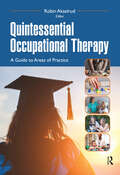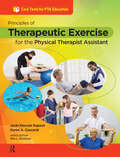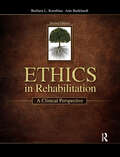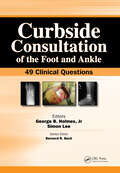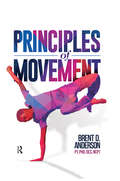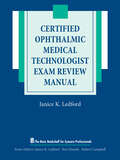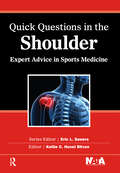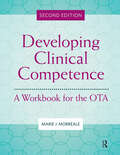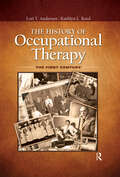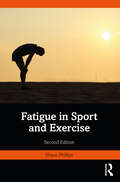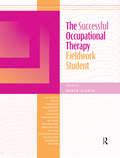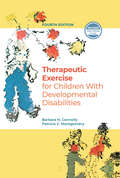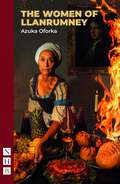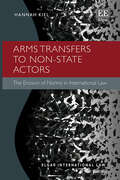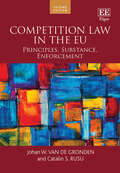- Table View
- List View
Quintessential Occupational Therapy: A Guide to Areas of Practice
by Robin AkselrudOffering a glimpse into the daily schedule, caseload, and roles of clinicians in more than 15 areas of practice, Quintessential Occupational Therapy: A Guide to Areas of Practice is an essential resource for recent graduates and occupational therapists looking to enter a new area of practice.Each chapter focuses on a different area of practice—from outpatient rehabilitation to home care—and is authored by a team of seasoned clinicians who offer advice, work samples, and tips for those entering that area of practice. Quintessential Occupational Therapy also features experts across states and settings to provide the reader with a holistic view and understanding of the practice area they seek to enter.What’s included in Quintessential Occupational Therapy: Sample forms and documents used in a variety of practice settings Common treatment plans and information on clinical diagnoses in each area of practice Guides for testing and relevant clinical information for each setting Quintessential Occupational Therapy: A Guide to Areas of Practice will equip readers with the knowledge and understanding of a variety of practice settings in occupational therapy and is perfect for recent graduates and practicing clinicians alike.
Principles of Therapeutic Exercise for the Physical Therapist Assistant (Core Texts for PTA Education)
by Jacqueline Kopack Karen CascardiPrinciples of Therapeutic Exercise for the Physical Therapist Assistant is a textbook that provides PTA educators, students, and practicing clinicians with a guide to the application of therapeutic exercise across the continuum of care.Written by 2 seasoned clinicians with more than 40 years of combined PTA education experience, Principles of Therapeutic Exercise for the Physical Therapist Assistant focuses on developing the learner’s ability to create effective therapeutic exercise programs, as well as to safely and appropriately monitor and progress the patient within the physical therapy plan of care. The content is written in a style conducive to a new learner developing comprehension, while still providing adequate depth as well as access to newer research.Included in Principles of Therapeutic Exercise for the Physical Therapist Assistant are:• Indications, contraindications, and red flags associated with various exercise interventions• Documentation tips• Easy-to-follow tables to aid in understanding comprehensive treatment guidelines across the phases of rehabilitation• Eye on the Research sections throughout the text dedicated to current research and evidence-based practicesAlso included with the text are online supplemental materials for faculty use in the classroom, consisting of PowerPoint slides and an Instructor’s Manual (complete with review questions and quizzes).Created specifically to meet the educational needs of PTA students, faculty, and clinicians, Principles of Therapeutic Exercise for the Physical Therapist Assistant is an exceptional, up-to-date guidebook that encompasses the principles of therapeutic science across the entire continuum of care.
Ethics in Rehabilitation: A Clinical Perspective
by Ann Burkhardt Barbara KornblauEthical decision-making is a critical component in the broad spectrum of rehabilitation and health care professions today. Ethics in Rehabilitation: A Clinical Perspective, Second Edition was developed to give health and rehabilitation professionals the knowledge and tools they need to approach and solve the ethical dilemmas that challenge them in everyday practice.Following an introduction to ethical theories and principles, Drs. Kornblau and Burkhardt furnish readers with a brief overview of legal principles that may impact ethical decision making, then examine the relationship between ethical and legal principles that clinicians may encounter. The second section provides readers with an opportunity to apply what they have learned and includes more than 100 ethical dilemmas covering a wide variety of practice-related topics. Further reinforcing the concepts, the final sections consist of ethical dilemma worksheets and a set of additional learning resources to assist in the examination and resolution of ethical dilemmas.Features:• More than 100 sample ethical dilemmas extracted from actual practice experiences • Ethical dilemma worksheets to guide learning and illustrate course of action • Extensive set of appendices including sample laws and regulations • Online access to internet resources of state licensure and related lawsEthics in Rehabilitation: A Clinical Perspective, Second Edition offers readers a practical approach to ethics within a clinical context to allow practitioners, educators, and researchers to raise questions, attempt to answer them, and promote and improve ethical practice in rehabilitation.
Scrutinising Polarisation: Patterns and Consequences of Occupational Transformation in the Swedish Labour Market (Routledge Studies in the Sociology of Work, Professions and Organisations)
by Tomas Berglund Ylva Ulfsdotter ErikssonThis book scrutinises polarisation in Sweden, identifying patterns and variations in labour market transformation and exploring the consequences in terms of jobs, income, prestige, unionization and employment security, as well as the effects on different social groups. Through a series of empirical studies, it sheds light on changes in the occupational structure and the ways in which these changes interact with other societal trends, such as increased temporary employment, rising migration and decreased unionization, whilst also exploring changes in the evaluation of occupations and attitudes towards trade unions. Drawing on distinctly sociological perspectives, it shows how transformations in society and the labour market have affected conditions for individuals and considers whether these changes reinforce existing inequalities occasioned by polarisation or create new ones. Scrutinising Polarisation considers whether and how the Swedish labour market has polarized – and, if so, what this means for individual employees and labour organizations. It will therefore appeal to scholars with interests in the sociology of work and professions, social inequalities and labour market transformations.
Curbside Consultation of the Foot and Ankle: 49 Clinical Questions (Curbside Consultation in Orthopedics)
Are you looking for concise, practical answers to those questions that are often left unanswered by traditional foot and ankle references? Are you seeking brief, evidence-based advice for complicated cases or controversial decisions? Curbside Consultation of the Foot and Ankle: 49 Clinical Questions provides quick answers to the tricky questions most commonly posed during a “curbside consultation” between orthopedic surgeons. Drs. George B. Holmes, Jr. and Simon Lee have designed this unique reference which offers expert advice, preferences, and opinions on tough clinical questions commonly associated with the foot and ankle. The unique Q&A format provides quick access to current information related to the foot and ankle with the simplicity of a conversation between two colleagues. Numerous images, diagrams, and references allow readers to browse large amounts of information in an expedited fashion. Curbside Consultation of the Foot and Ankle: 49 Clinical Questions provides information basic enough for residents while also incorporating expert advice that even high-volume clinicians will appreciate. Practicing orthopedic surgeons, orthopedic residents, foot and ankle specialists, and medical students will benefit from the user-friendly, casual format and the expert advice contained within.Some of the questions that are answered:• When do you do an allograft or autograft talar transplantation graft for a failed osteochondral talar lesion?• How do you treat an athlete with chronic lateral foot overload and peroneal tendonitis with a cavovarus foot?• How do you fix your syndesmotic injuries? Can I use tight-ropes now?• I have a 63 year old patient who had an ankle fracture 20 years ago. They are ready for a major procedure now. Should I perform an ankle arthrodesis or should I refer her out to someone for a total ankle arthroplasty? What are your criteria for a total ankle arthroplasty?• Do I need to use bone graft in foot and ankle surgery, autologous or allograft? What graft should I use?
Principles of Movement
by Brent AndersonFrom the founder of Polestar Pilates, Principles of Movement is a practical resource guide on movement science for movement practitioners, therapists, and anyone looking for a practical and easy approach to assess, facilitate, and enhance movement. With applications in physical therapy, occupational therapy, athletic training, kinesiology, physical education, Pilates training, yoga training, dance education, and more, Principles of Movement is designed to help the movement practitioner improve the quality of their practice by better understanding the integrated model of movement assessment and movement facilitation. The text focuses on how to facilitate the quality of movement—not just the quantity. Author Dr. Brent Anderson draws upon his 30 years of experience in rehabilitation and movement science, showing the strong correlation between motor control and biomechanics, and integrating new work on fascia, pain interpretation, and behavioral elements associated with movement. Principles of Movement is designed to facilitate problem solving and movement enhancement through a deeper understanding of universal movement principles. What’s included in Principles of Movement: • How to harness tools such as breath, mobility, dynamic alignment, control, and coordination to improve movement efficiency and performance, minimize injuries, and increase personal satisfaction through successful movement experiences without pain • Examples, practical applications, and teaching tips for movement practitioners • A guide to critical reasoning that applies the Principles of Movement algorithm to exercise selection and treatment planning • Teaching aids and applications that can be immediately integrated into practice, including verbal, tactile, and imagery cueingPrinciples of Movement provides students and practitioners alike with a framework to evaluate, facilitate, and optimize the quality of movement.
Certified Ophthalmic Medical Technologist Exam Review Manual (The Basic Bookshelf for Eyecare Professionals)
by Janice K. LedfordThe Basic Bookshelf for Eyecare Professionals is a series that provides fundamental and advanced material with a clinical approach to clinicians and students. A special effort was made to include information needed for the certification exams in ophthalmic and optometric assisting, low vision, surgical assisting, opticianry, and contact lens examiners.The Certified Ophthalmic Medical Technologist Exam Review Manual is a review book designed for those preparing for the COMT® certification exam. This manual offers some 600 multiple-choice questions on every topic listed in the test criteria, including advanced levels of tonometry, visual fields, color vision, clinical optics, motility, photography, pharmacology, and general medical knowledge. Material that is unique to COMTs, such as microbiology and special instruments & techniques, are also covered. Explanatory answers, often with supporting illustrations and tables as well as the reference from which the material was obtained, are offered to round out your study experience. Suggested study texts are listed, along with an appendix on how to take a practical examination.
Quick Questions in the Shoulder: Expert Advice in Sports Medicine (Quick Questions in Sports Medicine)
by Kelly BlivenAre you looking for concise, practical answers to questions that are often left unanswered by traditional sports medicine references? Are you seeking brief, up-to-date, expert advice for common issues that can be encountered when working with athletes?Quick Questions in the Shoulder: Expert Advice in Sports Medicine provides a unique format of concise and to the point responses with clinical application, backed by the latest research on shoulder injuries among athletes. Dr. Kellie C. Huxel Bliven and her contributors present 39 common clinical questions regarding the prevention, assessment, treatment, management, and rehabilitation of the shoulder. Co-published with the National Athletic Trainers’ Association, Quick Questions in the Shoulder: Expert Advice in Sports Medicine provides concise answers to 39 frequently asked clinical questions. Written in a conversational tone, the authors of the individual questions represent a variety of different backgrounds and are experts in their respective field. The variety of questions and brevity of responses will make this a book that is easy to read and reference at the point of care.Some sample sections and questions include: Factors related to shoulder functionHow does the trunk contribute to upper extremity function and injury risk in overhead athletes? Injury diagnosisWhat are the best clinical tests for determining if a patient has scapular dyskinesis and to determine if it is contributing to their shoulder pain and dysfunction? Injury treatment and rehabilitationWhat are the most effective glenohumeral mobilization techniques and when are they most appropriate to use to improve shoulder function and range of motion? The overhead athleteWhat assessments should be used in screening overhead athletes to determine who is at increased risk for injury and what are the most effective injury prevention strategies? Quick Questions in the Shoulder: Expert Advice in Sports Medicine is the perfect at-your-side resource for the athletic trainer, team physician, or sports medicine clinician looking for practical answers to sports-related shoulder injury questions. The concise and conversational tone allows the reader to readily apply the information into their everyday practice.
Developing Clinical Competence: A Workbook for the OTA
by Marie MorrealeA newly updated, user-friendly resource for occupational therapy assistant students and new practitioners, Developing Clinical Competence: A Workbook for the OTA, Second Edition assists readers in developing practical problem-solving and “‘real-life”’ skills essential for fieldwork and clinical practice. Maintaining the easy-to-read workbook format from the First Edition, this book is filled with learning activities, worksheets, and detailed answer explanations, as well as expanded chapter content and revised references.Marie J. Morreale breaks down competencies into step-by-step units to allow for independent study. With multiple choice, matching, true/false, and fill-in-the-blanks questions; case studies; vignettes; and experiential activities, this Second Edition presents helpful tips in their most useful format. Guiding the reader through occupational therapy clinical decision making, professional conduct, and meeting standards of care for various practice areas, each chapter is fully independent and can be read in the order most conducive to the reader’s individual learning needs. This text can help readers measure attainment of knowledge and skills when preparing for fieldwork, the national certification exam, or transitioning to entry-level practice.New for the Second Edition: Fundamental topics including effective communication, assessment of client function, safety, supervision, documentation, group process, and department management Additional questions regarding behavioral health and pediatric practice Expanded content for professionalism, ethics, cultural sensitivity, and interventions to support occupations Topics such as wheeled mobility, hand function development, infection control, feeding/eating, wound care basics, quality improvement, and more Added content regarding the American Occupational Therapy Association documents, evidence-informed practice, advocacy, chronic conditions, and new trends Incorporated concepts and principles from the Occupational Therapy Practice Framework: Domain and Process, Fourth Edition Included with the text are online supplemental materials for faculty use in the classroom. Addressing fundamental areas of occupational therapy practice for a wide variety of conditions, situations, and practice settings, Developing Clinical Competence: A Workbook for the OTA, Second Edition includes helpful hints and practical clinical tips to help the OTA implement appropriate interventions and communicate more effectively.
The History of Occupational Therapy: The First Century
by Kathlyn Reed Lori AndersenTo understand who we are and where we are going,we first need to understand who we were and where we came from.The History of Occupational Therapy: The First Century by Drs. Lori T. Andersen and Kathlyn L. Reed follows a chronological timeline, providing discussions and reflections on the influence of various personalities, politics, legislation and policy, economics, socio-cultural values, technology, and educational factors that led to the progressive maturation of the profession.The History of Occupational Therapy: The First Century includes photographs of pioneers, leaders, and advocates of occupational therapy; pictures of occupational therapy artifacts, including newspaper clippings and historical documents; maps showing historical locations in occupational therapy practice and education; and sidebars that give glimpses into personalities and events.Features: The only historical book on the profession’s first 100 years Scholarly book for teaching, professional, and personal use Included with the text are online supplemental materials for faculty use in the classroom. Features glimpses into occupational therapy personalities The History of Occupational Therapy: The First Century provides all occupational therapy practitioners and occupational therapy students with a historical context of the profession. Generous use of photographs and illustrations create a visually stimulating and scholarly book that provides the historical context of the profession, from the formative stages in the 18th century to the eve of the Centennial Celebration in 2017, as well as a glimpse into the future.“History can tell us that the seeming hardship, the self-doubts of efficacy, the searching for our roots are actually precursors for establishing a new strategic vision and plan that could put us in the forefront of progress.”Robert Bing, President, American Occupational Therapy Association, 1983
Fatigue in Sport and Exercise
by Shaun PhillipsFatigue is an important concern for athletes at all levels, recreational sport and exercise participants, athletic coaches, personal trainers, and fitness professionals. The study of fatigue is also important for students of the sport, exercise, and health sciences, as it enables a deeper understanding of fundamental physical function and the limitations behind human performance. There remains considerable debate about the definition of fatigue, what causes it, its impact during different forms of sport and exercise, and the multitude of factors that can influence the nature and severity of fatigue. The vast body of literature in these areas can make it challenging to understand what we know and what we still need to understand about fatigue in sport and exercise. The second edition of this book presents a fully revised and updated overview of the contemporary research evidence into sport and exercise fatigue. The book examines the latest thinking into how we conceptualise fatigue, as well as how we measure it. The fundamental science of fatigue is introduced, focussing predominantly on physiological aspects of energy depletion, metabolic acidosis, environmental challenges, electrolytes and minerals, and the perception of fatigue as it relates to mental fatigue and the central regulation of sport and exercise performance. Each chapter includes real case studies from sport and exercise, as well as useful features to aid learning and understanding such as definitions of key terms, guides to further reading, and discussion questions. Fatigue in Sport and Exercise, Second Edition is an invaluable companion for any degree-level course in sport and exercise science, fitness and training, or strength and conditioning.
The Successful Occupational Therapy Fieldwork Student
by Karen SladykThe Successful Occupational Therapy Fieldwork Student is a stimulating new book that paves the way to the profession of occupational therapy. This book fulfills the needs of all OT and OTA students throughout their entire education by fully preparing them for their fieldwork assignments. This is an imperative learning tool for all students since all curricula include Level I and II fieldwork requirements, ranging from the associate’s level to a master’s program.This complete fieldwork book contains a wide array of topics that guide the reader from the initial planning steps to the completion of successful fieldwork, including how to design fieldwork as a supervisor. It provides students with the opportunity to not only assess various situations, but also utilize their knowledge to demonstrate clinical reasoning. A multitude of activities are included from the first page to the last, designed to groom students for their fieldwork.The Successful Occupational Therapy Fieldwork Student is the ultimate resource for OT/OTA students and the clinicians who educate them, providing a wealth of information while allowing for clinical reasoning to occur. This one-of-a-kind book contains unique features that will prove beneficial to students at varying degrees of education.Features: Each chapter includes activities and assignments for students to complete as they prepare for fieldwork. The text is filled with real-life fieldwork student cases. The text teaches how to prevent problems that can occur, as well as how to fix them when they do.
Ethics in Rehabilitation: A Clinical Perspective
by Ann Burkhardt Barbara KornblauEthical decision-making is a critical component in the broad spectrum of rehabilitation and health care professions today. Ethics in Rehabilitation: A Clinical Perspective, Second Edition was developed to give health and rehabilitation professionals the knowledge and tools they need to approach and solve the ethical dilemmas that challenge them in everyday practice.Following an introduction to ethical theories and principles, Drs. Kornblau and Burkhardt furnish readers with a brief overview of legal principles that may impact ethical decision making, then examine the relationship between ethical and legal principles that clinicians may encounter. The second section provides readers with an opportunity to apply what they have learned and includes more than 100 ethical dilemmas covering a wide variety of practice-related topics. Further reinforcing the concepts, the final sections consist of ethical dilemma worksheets and a set of additional learning resources to assist in the examination and resolution of ethical dilemmas.Features:• More than 100 sample ethical dilemmas extracted from actual practice experiences • Ethical dilemma worksheets to guide learning and illustrate course of action • Extensive set of appendices including sample laws and regulations • Online access to internet resources of state licensure and related lawsEthics in Rehabilitation: A Clinical Perspective, Second Edition offers readers a practical approach to ethics within a clinical context to allow practitioners, educators, and researchers to raise questions, attempt to answer them, and promote and improve ethical practice in rehabilitation.
Therapeutic Exercise for Children with Developmental Disabilities
by Barbara H. Connolly Patricia MontgomeryTherapeutic Exercise for Children With Developmental Disabilities has been expanded and updated to include everything a student or professional needs to know when working with children with developmental disabilities. Continuing the emphasis on evidence-based practice from the previous editions, this comprehensive Fourth Edition enhances critical thinking and evaluation skills. Throughout the course of the text, Drs. Barbara H. Connolly and Patricia C. Montgomery present case studies of 5 children with various developmental disabilities to bring a problem-solving approach to each individual chapter topic. The case studies include 2 two children with cerebral palsy (GMFCS Levels I and V), a child with myelomeningocele, a child with Down syndrome, and a child with developmental coordination disorder and attention-deficit hyperactivity disorder. Each chapter’s examination, evaluation, and intervention recommendations are accompanied by specific treatment objectives and therapeutic activities, plus a companion website with 17 videos, which contains 90 minutes of content to illustrate concepts. Recent research and clinical recommendations, as well as related references, are also provided in each chapter. This Fourth Edition utilizes the American Physical Therapy Association’s Guide to Physical Therapist Practice 3.0 and the World Health Organization’s International Classification of Functioning, Disability, and Health--Children and Youth as its framework. The focus of the chapters is on children’s participation and empowerment, rather than body function and structure. Examples of new and updated topics in the Fourth Edition: • Practice in the NICU • Early mobility strategies • Communication strategies with children and families • Aquatic therapy • Upper extremity constraint-induced therapy • Mirror therapy • Lower extremity treadmill training With helpful videos, informative figures, and compelling case studies, Therapeutic Exercise for Children With Developmental Disabilities, Fourth Edition is the perfect resource for both students and practicing clinicians.
Specially Designed Instruction for Special Education: A Guide to Ensuring Quality IEP Implementation (Evidence-Based Instruction in Special Education)
by Rosemary TralliA new resource for teacher preparatory programs at institutes of higher education and school-based professional development, Specially Designed Instruction for Special Education: A Guide to Ensuring Quality IEP Implementation offers a detailed account of the legal requirements and evidence-based practices for educators to afford quality specialized instruction to eligible students.The latest entry in SLACK’s Evidence-Based Instruction in Special Education series, Specially Designed Instruction for Special Education provides educators with practical tools to define, plan, implement, and assess educational conditions and practices. After reading this text, special education teacher candidates and educators will possess the knowledge and skills to ensure student success through specially designed instruction, align interventions with student strengths and needs, and engage in collaborations to develop and implement quality Individualized Education Programs.What’s included in Specially Designed Instruction for Special Education: Individuals with Disabilities Education Act connections with references to federal regulations and relevant court cases Evidence-based practices and tools that support specialized instruction Key takeaways that summarize concepts and practices associated with the chapter content Included with the text are online supplemental materials for faculty use in the classroom.Specially Designed Instruction for Special Education provides readers with a comprehensive understanding of the composition and conditions of specialized instruction and the tools to ensure their adherence to the legal and programming components of specialized instruction.
The Women of Llanrumney (Nhb Modern Plays Ser.)
by Azuka OforkaLlanrumney plantation. Saint Mary Parish, Jamaica. 1765. Annie and Cerys are enslaved by the Morgan family from Wales. When Elizabeth Morgan is faced with the loss of her plantation, the slaves' future hangs in the balance. With a storm of rebellion brewing, Annie does everything she can to secure her future. But sooner or later she will have to face up to the horror and trauma all around her, including her own. Azuka Oforka's play The Women of Llanrumney is a powerful, searing drama that explores the impact of slavery and the lives of women who experienced it – those who benefitted from it, those who were brutalised by it and those who fought to destroy it. It premiered at Sherman Theatre, Cardiff, in 2024, directed by Patricia Logue.
Fanny (Nhb Modern Plays Ser.)
by Calum FinlayMeet Fanny Mendelssohn. You'll probably know of her younger brother Felix, from nineteenth-century smash hits like 'The Wedding March'. He was such a huge star that Queen Victoria requested a private concert, during which she sang her favourite of his compositions, a song called 'Italien'. The only problem is, that particular piece was actually composed by Fanny, though it was published under her brother's name. When Fanny intercepts the letter inviting Felix to play for the queen, she decides to hide it away, don her brother's clothes, and take his place at the palace… Calum Finlay's play Fanny is a joyful and irreverent comedy celebrating music, family and - at last - the work of a composer overlooked because of her sex. It opened at the Watermill Theatre, Newbury, in 2024.
Arms Transfers to Non-State Actors: The Erosion of Norms in International Law (Elgar International Law series)
by Hannah KielThis insightful book analyses the issue of norm erosion in international law by examining arms transfers to non-state actors. Balancing empirical research with legal theory, the author dissects recent case studies, tracing individual changes in norms against a background of systemic transformation.Arms Transfers to Non-State Actors follows changes in the prohibition of arms transfers to non-state actors since the pivotal International Court of Justice's Nicaragua ruling in 1986. Hannah Kiel critically discusses the legal developments through relevant case studies, including Abkhazia, Bosnia, Congo, Eastern Ukraine, Kosovo, Libya, Northern Iraq, South Ossetia, Syria and Yemen. Adopting a customary law perspective while also placing the narratives of states in the context of international structural changes, Kiel emphasises the interplay between state practice and the strengthening of a human rights-based paradigm. Kiel ultimately shows that changes in norms at the individual level indicate a larger transformation in the international order, and while the arming of non-state actors remains formally illegal, the prohibition of this practice is informally eroding.Interdisciplinary in scope, this book provides valuable insights for scholars and researchers of public international law, human rights, international humanitarian law, and international relations. It is also of great benefit to human rights lawyers, policymakers, and diplomats.
Research Handbook on the Green Economy (Elgar Handbooks in Energy, the Environment and Climate Change)
Outlining how the concepts of green economy and green growth have become the forefront of policy and political debates within the last decade, this compelling Research Handbook investigates the policies and plans that utilise these concepts at both the local and global level to achieve a truly green economy.Commencing with a review of green economy’s development from the 1980s onwards, the Research Handbook on the Green Economy examines its progression through the 1990s, illustrating the lack of progress in the early years until sustainable development gathered traction in the early 2000s. Taking a theoretical approach to green economy research, this Research Handbook examines recent trends and developments within global industries and sectors including product circulation and manufacturing, alongside green services, construction, renewable energy and tourism. Chapters also discuss the directions and challenges for future research, in particular the concepts of ‘lean’, waste reduction and greenwashing in the green economy.This timely and fascinating book will be an excellent resource for scholars and researchers in the fields of environmental economics, economic geography, business and management studies, and environmental governance and regulation. The illustrated future strategies highlighted in this Research Handbook will also provide excellent guidance for policymakers at both local and national government levels.
Reservations to Optional Declarations Granting Jurisdiction to the International Court of Justice
by Robert KolbIn this incisive book, Robert Kolb sets out a short but nevertheless in-depth analysis of optional declarations for the jurisdiction of the International Court of Justice, and of the various reservations which restrict the jurisdiction. Concise and readable, the book examines the true scope of this jurisdiction once the numerous carve-outs of the reservations are subtracted.Kolb constructs a detailed exploration of the reservations involved and their effects. After an overview of the optional declarations, chapters cover key topics such as reciprocity and how one should interpret the text of the many reservations. They delve into material reservations, including military and security, or reserved domain, territorial reservations and those relating to specific treaties, as well as temporal reservations and finally personal reservations.Succinct and practical, this book is an important resource for lawyers and academics concerned with international law, especially those interested in the work of the International Court of Justice. It will also appeal to students and scholars of human rights, humanitarian law and terrorism and security.
How to Think Like a Realist: A Methodology for Social Science (How to Research Guides)
by Raymond PawsonHow to Think Like a Realist is Ray Pawson’s seminal book on realist social inquiry, boldly linking social research to clinical and physical science and challenging many methodological shibboleths.This unique book pairs outstanding clarity of detail with an accessible approach, exploring the three great methodological challenges in social research: how to think about causality, objectivity, and generality. Presented in accessible bite-sized episodes, it offers a rich diet of practical illustrations, enabling the reader to absorb the variety and breadth of realist inquiry. How to Think Like a Realist is written in Ray Pawson’s customary style; informed, bravely non-conformist and with a splash of mischief. Pawson offers a dextrous rebuttal to the threats that social inquiry faces in an era of post-truth. The text provides crucial guidance for those looking to better understand the central tenets of social science research methodology in the twenty-first century.This innovative book will be an essential resource for students and early career researchers as well as experienced academics and practitioners from across all social science disciplines. Its breadth of coverage and accessibility makes it an ideal text for teaching social research methodology at both undergraduate and postgraduate levels.
Research Handbook on Public Affairs: Connecting Evidence and Strategy (Elgar Handbooks in Public Administration and Management)
In this innovative Handbook, Arco Timmermans brings together a diverse range of experts to scrutinise the current field of public affairs, what can be learned from it and its compatibility with democracy and open society. Through this multidisciplinary focus, the Handbook aims to closely connect the spheres of research and practice within public affairs.Chapters map out the roots and foundations of public affairs, including its status as a discipline and profession, and dissect perspectives on its context, from direct organisational settings to the wider environment. Contributors analyse research for the evidence basis of public affairs, competencies in the field, and the role of ethics, especially in the relationship between lobbying and public interest. Ultimately, this Handbook assesses the current landscape as well as proposing future perspectives in an area where attention to further development is crucial.Providing a nuanced exploration of an expanding field of research and practice, this Handbook will prove a vital reference point to scholars and students of public affairs, political science, communication, management science, public administration, and regional government. Its practical applications will also make it relevant to public affairs practitioners, as well as journalists and media professionals looking to build their knowledge of the field.
The Regulatory Landscape of Ship Recycling: Justice, Environmental Principles, and the European Union as a Global Leader
by Ioanna Hadjiyianni Kleoniki PouikliIn this authoritative book, Ioanna Hadjiyianni and Kleoniki Pouikli incisively map out the regulatory landscape of ship recycling, exploring the main international and European regulatory approaches that govern its environmental impacts. In light of the transnational demands of environmental justice, they critically assess the interaction between multiple regimes from the perspective of key environmental principles and the role of the EU as a global standard setter for shipbreaking.Analysing the complex business of dismantling end-of-life ships, the book takes a deeper look at the practice of shipbreaking and examines the appropriate balance between environmental protection, economic development and social justice. The authors survey the EU’s role as a significant global actor on environmental protection and maritime issues, often determining the relationship between the different regimes before they are settled at the international level. They also examine the effectiveness of these regimes, as well as their legal uncertainties and jurisdictional loopholes, through the lens of environmental principles and justice and in the context of recent developments related to the European Green Deal.The Regulatory Landscape of Ship Recycling provides valuable insights for academics and postgraduate students in law, politics and environmental studies. Legal practitioners in environmental law, sustainability law, maritime and shipping law and industry actors involved in shipbreaking will equally benefit from this fundamental resource.
Islamic Economics and Human Well-being: Justice, Moderation and Sharing (Studies in Islamic Finance, Accounting and Governance series)
by Muhammad A. KhanThe study of Islamic economics provides an interesting complement to conventional economics as they both study economic behaviour to enhance human well-being. Muhammad Akram Khan articulates an expert view on how to use distinct approaches to achieve this in the context of Islamic economics.In this comprehensive book, Akram Khan not only illustrates the empirical evidence found in traditional economics but also explores the divine revelation found in the Qur’an and the traditions of the Prophet Muhammad. Highlighting the five dimensions of Islamic justice, namely equality, accountability, reciprocity, fairness and empowering the weak, the book emphasises moderation in the creation and consumption of wealth and outlines a plan for sharing resources with those in need. It goes a step further from material well-being to demonstrate how enhancing human happiness is the goal for a modern society.This visionary read will be an excellent resource for academics involved in teaching, researching, and writing on Islamic economics. It will also be of great benefit to policy makers and economic managers in Muslim and Western countries who would like to focus on social and economic justice in their societies.
Competition Law in the EU: Principles, Substance, Enforcement: Second Edition
by Johan W. van de Gronden Catalin S. RusuThis thoroughly revised and updated second edition provides an enhanced understanding of EU competition law, exploring significant substantive and enforcement issues relating to antitrust, merger control, the Digital Markets Act and state aid law. While considering well-established doctrines and landmark judgements, the textbook also addresses recent developments such as digitalisation, sustainability and globalisation, and how these issues will influence future inquiry into competition law. This incisive textbook is an invaluable resource for advanced undergraduate and postgraduate students and scholars of competition and European law. It is additionally beneficial for researchers and practitioners of comparative competition law; in particular, it is a useful guide for in-house company training courses. Key Features:New discussions on the Digital Markets Act and the Foreign Subsidies RegulationCritical assessment of the impact of recent developments such as sustainability and globalisation on competition lawAnalysis of the interplay between domestic and European competition law through discussion of national competition rules and frameworksEvaluation of the role of enforcement in competition law
